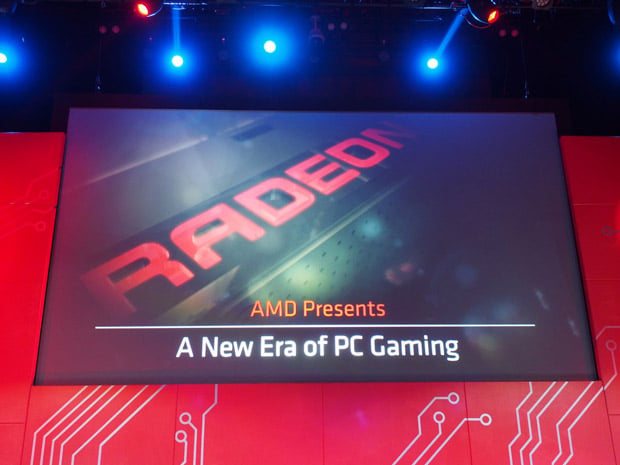AMD Flaunts Fiji, Ferocious Radeon R9 Fury X, 6-Inch R9 Nano, ‘Project Quantum’ And Radeon 300 Series
AMD hosted an event today for the tech press to announce new graphics solutions ranging from the bottom to the top ($99 on up to $649). AMD says that it has a graphics solution that will fit the budget of just about any gamer, and from the looks of it, NVIDIA is going to have some pretty stiff competition this summer. First up is the new range of R7 300 Series cards that is aimed squarely at the eSports audience — gamers that AMD says are typically running at 1080p. All of AMD’s new eSports-minded cards are based on Graphics Core Next Technology, and include:
- Radeon R7 360: $99, 2GB memory, 1080p gaming resolution
- Radeon R7 370: $149, 4GB GDDR5 memory, 1080p gaming resolution
For gamers that want a little bit more power, there’s the new R9 300 Series (just think of them as R9 280s with higher clocks and 8GB of memory). Members of this family include:
- Radeon R9 380: $199, 4GB GDDR5 memory, 1440p gaming resolution
- Radeon R9 390: $329, 8GB GDDR5 memory, 4K gaming resolution
- Radeon R9 390X: $429, 8GB GDDR5 memory, 4K gaming resolution
All of these cards will be available on Thursday, and all of course support Microsoft’s DirectX 12, which ships with Windows 10 on July 29. Games supporting DirectX 12 will begin shipping shortly after.
But HotHardware readers of course don’t want to just hear about rebadged Radeons; you want to hear about the latest and greatest graphics tech. Thankfully, AMD delivered today with the official announcement of its Fiji graphics cards that feature onboard High Bandwidth Memory (HBM), offering 3x the performance-per-watt of GDDR5. As AMD CEO Lisa Su described, Fiji is the “Most complex and highest performance GPU we have ever built.”
Fiji has 1.5x the performance-per-watt of the R9 290X, and was built with a focus on 4K gaming. The chip itself features 4096 stream processor and is comprised of 8.9 billion transistors. It has a graphics clock of 1050MHz and is rated at an astonishing 8.6 TFLOPs. And thanks to AMD’s ability to lower power consumption through the use of HBM and efficiency in its GPU design, there will be plenty of overhead for overclocking.
As we previously reported, Fiji will initially be available in two variants: the first is the Radeon R9 Fury (air cooled), while the second is the Radeon R9 Fury X (water-cooled). The Radeon R9 Fury will go on sale July 14 for $549 while the Radeon Fury X (1.5x performance-per-watt of a Radeon R9 290X) will be available June 24 for $649.

AMD CEO Lisa Su holding a Radeon R9 Nano


AMD's Chris Hook, aka "The Man," Holds Two Fiji GPUs, One In Each Mitt
The use of HBM also allows AMD to make more efficient use of PCB real estate (HBM requires 95% less PCB surface space are than GDDR5), which is opening up the doors for more innovative form-factors. AMD mentioned two during today’s press conference, with the first being the Radeon R9 Nano. This 6-inch card will be available this summer offering 2x the performance-per-what of a Radeon R9 290X while at the same time delivering significantly better performance. The second is Project Quantum, which is a small form-factor PC that manages to cram in not one, but two Fiji GPUs. The processor, GPUs, and all other hardware is incorporated into the bottom of the chassis, while the cooling solution is integrated into the top of the case.
AMD says that it’s working with its elite PC partners to bring this solution to market, and we simply can’t wait to see it cross our test benches. And needless to say, we definitely can’t wait to see how the Radeon R9 Fury X stacks up against NVIDIA’s similarly priced GeForce GTX 980 Ti.







